Morphological Control of Polymer Spherulites via Manipulating Radial Lamellar Organization upon Evaporative Crystallization: A Mini Review
Abstract
:1. Introduction
2. Morphological Control of Various Spherulites of Achiral Orthorhombic PCL
2.1. Manipulating the Stacking of Radial Lamellae to Prepare Concentric Ringed Spherulites
2.2. Modulating the Periodic Orienatation of Radial Lamellae to Produce PCL Extinction-Banded Spherulites
3. Tuning Radial Lamellar Organization to Construct Diverse PCL24.5k-b-PEO5.0k Spherulites
4. Collaborative Tuning of Lamellar Packing and Orientation to Yield a Nested Ring-Banded Pattern
5. Structural Evolution and Dynamic of Ring-Banded Spherulites via Evaporative Crystallization
5.1. Nontraditionally-Concentric Ringed Spherulites
5.2. Classical Extinction Banded Spherulites
6. Crystallization Mechanisms of Different Ring-Banded Spherulites upon Solution Evaporation
6.1. Rhythmic Crystal Growth Mechanism under Evaporative Crystallization
6.2. Solvent Evaporation Assisted Enhancing Model for Lamellar Twisting
7. Conclusions and Outlooks
Acknowledgments
Author Contributions
Conflicts of Interest
References
- Piorkowska, E.; Rutledge, G.C. Handbook of Polymer Crystallization; John Wiley & Sons, Inc.: Hoboken, NJ, USA, 2013. [Google Scholar]
- Reiter, G.; Strobl, G.R. Progress in Understanding of Polymer Crystallization; Springer: Berlin/Heidelberg, Germany, 2007. [Google Scholar]
- Guo, Q.P. Polymer Morphology; John Wiley & Sons, Inc.: Hoboken, NJ, USA, 2016. [Google Scholar]
- Bassett, D.C. Principles of Polymer Morphology; Cambridge University Press: Cambridge, UK, 1981. [Google Scholar]
- Shtukenberg, A.G.; Punin, Y.O; Gunn, E.; Kahr, B. Spherulites. Chem. Rev. 2012, 112, 1805–1838. [Google Scholar] [CrossRef] [PubMed]
- Bassett, D.C. Polymer spherulites: A modern assessment. J. Macromol. Sci. Phys. 2003, B42, 227–256. [Google Scholar] [CrossRef]
- Ramanathan, M.; Darling, S.B. Mesoscale morphologies in polymer thin films. Prog. Polym. Sci. 2011, 36, 793–812. [Google Scholar] [CrossRef]
- Crist, B.; Schultz, J.M. Polymer spherulites: A critical review. Prog. Polym. Sci. 2016, 56, 1–63. [Google Scholar] [CrossRef]
- Woo, E.M.; Lugito, G. Origins of periodic bands in polymer spherulites. Eur. Polym. J. 2015, 71, 27–60. [Google Scholar] [CrossRef]
- Lotz, B.; Cheng, S.Z.D. A critical assessment of unbalanced surface stresses as the mechanical origin of twisting and scrolling of polymer crystals. Polymer 2005, 46, 577–610. [Google Scholar] [CrossRef]
- Keller, A. A note on single crystals in polymers: Evidence for a folded chain configuration. Philos. Mag. 1957, 2, 1171–1175. [Google Scholar] [CrossRef]
- Chan, C.M.; Li, L. Direct observation of the growth of lamellae and spherulites by AFM. Adv. Polym. Sci. 2005, 188, 1–41. [Google Scholar]
- Zhou, J.J.; Liu, J.G.; Yan, S.K.; Dong, J.Y.; Li, L.; Chan, C.M.; Schultz, J.M. Atomic force microscopy study of the lamellar growth of isotactic polypropylene. Polymer 2005, 46, 4077–4087. [Google Scholar] [CrossRef]
- Xu, J; Ye, H.M.; Liu, J.; Guo, B.H. Crystallization Mechanism of Polymer Banded Spherulites. Chin. Polym. Bull. 2011, 4, 144–155. [Google Scholar]
- Nurkhamidah, S.; Woo, E.M. Mechanisms of Multiple Types of Lamellae and Spherulites in Poly(l-lactic acid) Interacting with Poly(4-vinyl phenol). Macromol. Chem. Phys. 2013, 214, 2345–2354. [Google Scholar] [CrossRef]
- Nurkhamidah, S.; Woo, E.M.; Tashiro, K. Optical Birefringence Patterns and Corresponding Lamellar Alteration Induced by Solvent Vapor on Poly(l-lactic acid) Diluted with Poly(1,4-butylene adipate). Macromolecules 2012, 45, 7313–7316. [Google Scholar] [CrossRef]
- Lugito, G.; Woo, E.M.; Chuang, W.T. Interior Lamellar Assembly and Optical Birefringence in Poly(trimethylene terephthalate) Spherulites: Mechanisms from Past to Present. Crystals 2017, 7, 56. [Google Scholar] [CrossRef]
- Lugito, G.; Woo, E.M. Novel approaches to study the crystal assembly in banded spherulites of poly(trimethylene terephthalate). CrystEngComm 2016, 18, 6158–6165. [Google Scholar] [CrossRef]
- Woo, E.M.; Lugito, G.; Tsai, J.-H.; Müller, A.J. Hierarchically Diminishing Chirality Effects on Lamellar Assembly in Spherulites Comprising Chiral Polymers. Macromolecules 2016, 49, 2698–2708. [Google Scholar] [CrossRef]
- Lugito, G.; Woo, E.M.; Chang, S.M. Periodic extinction bands composed of all flat-on lamellae in poly(dodecamethylene terephthalate) thin films crystallized at high temperatures. J. Polym. Sci. Part B Polym. Phys. 2017, 55, 601–611. [Google Scholar] [CrossRef]
- Woo, E.M.; Tsai, W.T.; Lugito, G. Interior Dissection on Domain-Dependent Birefringence Types of Poly(3-hydroxybutyrate) Spherulites in Blends. Macromolecules 2017, 50, 283–295. [Google Scholar] [CrossRef]
- Woo, E.M.; Lugito, G. Cracks in Polymer Spherulites: Phenomenological Mechanisms in Correlation with Ring Bands. Polymers 2016, 8, 329. [Google Scholar] [CrossRef]
- Lugito, G.; Woo, E.M. Three Types of Banded Structures in Highly Birefringent Poly(trimethylene terephthalate) Spherulites. J. Polym. Sci. Part B Polym. Phys. 2016, 54, 1207–1216. [Google Scholar] [CrossRef]
- Lugito, G.; Woo, E.M.; Hsieh, Y.T. Transitional Ring Bands Constructed by Discrete Positive- and Negative-Birefringence Lamellae Packed in Poly(1,6-hexamethylene adipate) Spherulites. Macromolecules 2015, 48, 7953–7967. [Google Scholar] [CrossRef]
- Prud’homme, R.E. Crystallization and morphology of ultrathin films of homopolymers and polymer blends. Prog. Polym. Sci. 2016, 54–55, 214–231. [Google Scholar] [CrossRef]
- Chen, Y.F; Woo, E.M.; Li, S.H. Dual Types of Spherulites in Poly(octamethylene terephthalate) Confined in Thin-Film Growth. Langmuir 2008, 24, 11880–11888. [Google Scholar] [CrossRef] [PubMed]
- Nurkhamidah, S.; Woo, E.M. Unconventional Non-birefringent or Birefringent Concentric Ring-Banded Spherulites in Poly(l-lactic acid) Thin Films. Macromol. Chem. Phys. 2013, 214, 673–680. [Google Scholar] [CrossRef]
- Li, Y.G.; Huang, H.Y.; Wang, Z.B.; He, T.B. Tuning Radial Lamellar Packing and Orientation into Diverse Ring-Banded Spherulites: Effects of Structural Feature and Crystallization Condition. Macromolecules 2014, 47, 1783–1792. [Google Scholar] [CrossRef]
- Lugito, G.; Yang, C.Y.; Woo, E.M. Phase-Separation Induced Lamellar Re-Assembly and Spherulite Optical Birefringence Reversion. Macromolecules 2014, 47, 5624–5632. [Google Scholar] [CrossRef]
- Ye, H.M.; Xu, J.; Guo, B.H.; Iwata, T. Left- or Right-Handed Lamellar Twists in Poly[(R)-3-hydroxyvalerate] Banded Spherulite: Dependence on Growth Axis. Macromolecules 2009, 42, 694–701. [Google Scholar] [CrossRef]
- Wang, Y.; Chan, C.M.; Li, L.; Ng, K.M. Concentric-ringed structures in polymer thin films. Langmuir 2006, 22, 7384–7390. [Google Scholar] [CrossRef] [PubMed]
- Duan, Y.X.; Zhang, Y.; Yan, S.K.; Schultz, J.A. In situ AFM study of the growth of banded hedritic structures in thin films of isotactic polystyrene. Polymer 2005, 46, 9015–9021. [Google Scholar] [CrossRef]
- Duan, Y.X.; Jiang, Y.; Jiang, S.D.; Li, L.; Yan, S.K.; Schultz, J.M. Depletion-induced nonbirefringent banding in thin isotactic polystyrene thin films. Macromolecules 2004, 37, 9283–9286. [Google Scholar] [CrossRef]
- Li, J.; Li, Y.; Zhou, J.; Yang, J.; Jiang, Z.Q.; Chen, P.; Wang, Y.Z.; Gu, Q.; Wang, Z.B. Increasing Lamellar Twisting Frequency with Poly(lactic acid) Segments Incorporation in Poly(trimethylene terephthalate) Ring-Banded Spherulites. Macromolecules 2011, 44, 2918–2925. [Google Scholar] [CrossRef]
- Chen, J.; Yang, D.C. Phase behavior and rhythmically grown ring-banded spherulites in blends of liquid crystalline poly(aryl ether ketone) and poly(aryl ether ether ketone). Macromolecules 2005, 38, 3371–3379. [Google Scholar] [CrossRef]
- Chen, J.; Yang, D.C. Nature of the ring-banded spherulites in blends of aromatic poly(ether ketone)s. Macromol. Rapid Commun. 2004, 25, 1425–1428. [Google Scholar] [CrossRef]
- Okabe, Y.; Kyu, T.; Saito, H.; Inoue, T. Spiral crystal growth in blends of poly(vinylidene fluoride) and poly(vinyl acetate). Macromolecules 1998, 31, 5823–5829. [Google Scholar] [CrossRef]
- Keith, H.D.; Padden, F.J. A Phenomenological Theory of Spherulitic Crystallization. J. Appl. Phys. 1963, 34, 2409–2421. [Google Scholar] [CrossRef]
- Luo, C.X.; Huang, W.H.; Wang, H.F.; Han, Y.C. Formation of nonextinct ring-banded textures and multistacked lamella of tetra-aniline-block-poly(L-lactide) rod-coil diblock oligomer films induced by solvent vapor treatment. J. Chem. Phys. 2007, 127, 244903. [Google Scholar] [CrossRef] [PubMed]
- Shao, H.F.; Ma, Y.P.; Nie, H.R.; He, A.H. Solvent vapor annealing induced polymorphic transformation of polybutene-1. Chin. J. Polym. Sci. 2016, 34, 1141–1149. [Google Scholar] [CrossRef]
- Huang, S.Y.; Li, H.F.; Wen, H.Y; Yu, D.H.; Jiang, S.C.; Li, G.; Chen, X.S.; An, L.J. Solvent micro-evaporation and concentration gradient synergistically induced crystallization of poly(l-lactide) and ring banded supra-structures with radial periodic variation of thickness. CrystEngComm 2014, 16, 94–101. [Google Scholar] [CrossRef]
- Huang, S.Y.; Li, H.F.; Shang, Y.R.; Yu, D.H.; Li, G.; Jiang, S.C.; Chen, X.S.; An, L.J. Chloroform micro-evaporation induced ordered structures of poly(L-lactide) thin films. RSC Adv. 2013, 3, 13705–13711. [Google Scholar] [CrossRef]
- Woo, E.M.; Lugito, G.; Yang, C.E. Analysis of crystal assembly in banded spherulites of phthalic acid upon solvent evaporation. CrystEngComm 2016, 18, 977–985. [Google Scholar] [CrossRef]
- Wang, Z.B.; Hu, Z.J.; Chen, Y.Z.; Gong, Y.M.; Huang, H.Y.; He, T.B. Rhythmic growth-induced concentric ring-banded structures in poly(ε-caprolactone) solution-casting films obtained at the slow solvent evaporation. Macromolecules 2007, 40, 4381–4385. [Google Scholar] [CrossRef]
- Wang, Z.B.; Alfonso, G.C.; Hu, Z.J.; Zhang, J.D.; He, T.B. Rhythmic Growth-Induced Ring-Banded Spherulites with Radial Periodic Variation of Thicknesses Grown from Poly(ε-caprolactone) Solution with Constant Concentration. Macromolecules 2008, 41, 7584–7595. [Google Scholar] [CrossRef]
- Li, Y.G.; Wang, Z.B.; Gu, Q.; Wu, X.D. Enhance understanding of rhythmic crystallization in confined evaporating polymer solution films: from environment to solution film and then to one period. RSC Adv. 2016, 6, 45241–45249. [Google Scholar] [CrossRef]
- Li, Y.G.; Huang, H.Y.; He, T.B.; Wang, Z.B. Coupling between crystallization and evaporation dynamics: Periodically nonlinear growth into concentric ringed spherulites. Polymer 2013, 54, 6628–6635. [Google Scholar] [CrossRef]
- Li, Y.G.; Huang, H.Y.; He, T.B.; Wang, Z.B. Band-to-Nonband Transition into Unique Poly(ε-caprolactone) Crystals by Modulating the Interplay of Diffusion and Growth. ACS Macro Lett. 2012, 1, 718–722. [Google Scholar] [CrossRef]
- Li, Y.G.; Wu, L.; He, C.D.; Wang, Z.B.; He, T.B. Strong enhancement of the twisting frequency of achiral orthorhombic lamellae in poly(ε-caprolactone) banded spherulites via evaporative crystallization. CrystEngComm 2017, 19, 1210–1219. [Google Scholar] [CrossRef]
- Li, Y.G.; Huang, H.Y.; He, T.B.; Wang, Z.B. Rhythmic Growth Combined with Lamellar Twisting Induces Poly(ethylene adipate) Nested Ring-Banded Structures. ACS Macro Lett. 2012, 1, 154–158. [Google Scholar] [CrossRef]
- Keith, H.D.; Padden, F.J. Twisting orientation and the role of transient states in polymer crystallization. Polymer 1984, 25, 28–42. [Google Scholar] [CrossRef]
- Keith, H.D. Banding in spherulites: two recurring topics. Polymer 2001, 42, 9987–9993. [Google Scholar] [CrossRef]
- Keith, H.D.; Padden, F.J. Banding in polyethylene and other spherulites. Macromolecules 1996, 29, 7776–7786. [Google Scholar] [CrossRef]
- Woo, E.M.; Wu, P.L.; Wu, M.C.; Yan, K.C. Thermal behavior of ring-band versus Maltese-cross spherulites: Case of monomorphic poly(ethylene adipate). Macromol. Chem. Phys. 2006, 207, 2232–2243. [Google Scholar] [CrossRef]
- Wang, Z.G.; An, L.J.; Jiang, B.Z.; Wangh, X.H. Periodic radial growth in ring-banded spherulites of poly(ε-caprolactone)/poly(styrene-co-acrylonitrile) blends. Macromol. Rapid Commun. 1998, 19, 131–133. [Google Scholar] [CrossRef]
- Mareau, V.H.; Prud’homme, R.E. Growth rates and morphologies of miscible PCL/PVC blend thin and thick films. Macromolecules 2003, 36, 675–684. [Google Scholar] [CrossRef]
- Chatani, Y.; Okita, Y.; Tadokoro, H.; Yamashit, Y. Structure studies of polyesters. 3. Crystal structure of poly (ε-caprolactone). Polym. J. 1970, 1, 555–562. [Google Scholar] [CrossRef]
- Keith, H.D.; Padden, F.J.; Russell, T.P. Morphological changes in polyesters and polyamides induced by blending with small concentrations of polymer diluents. Macromolecules 1989, 22, 666–675. [Google Scholar] [CrossRef]
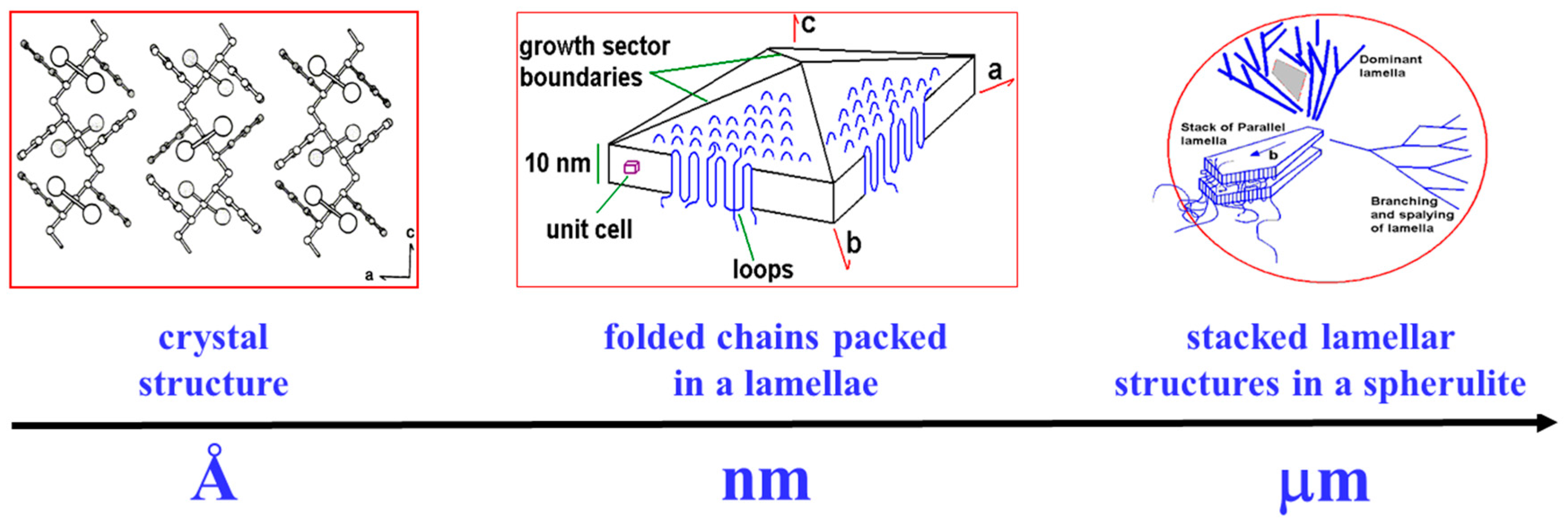
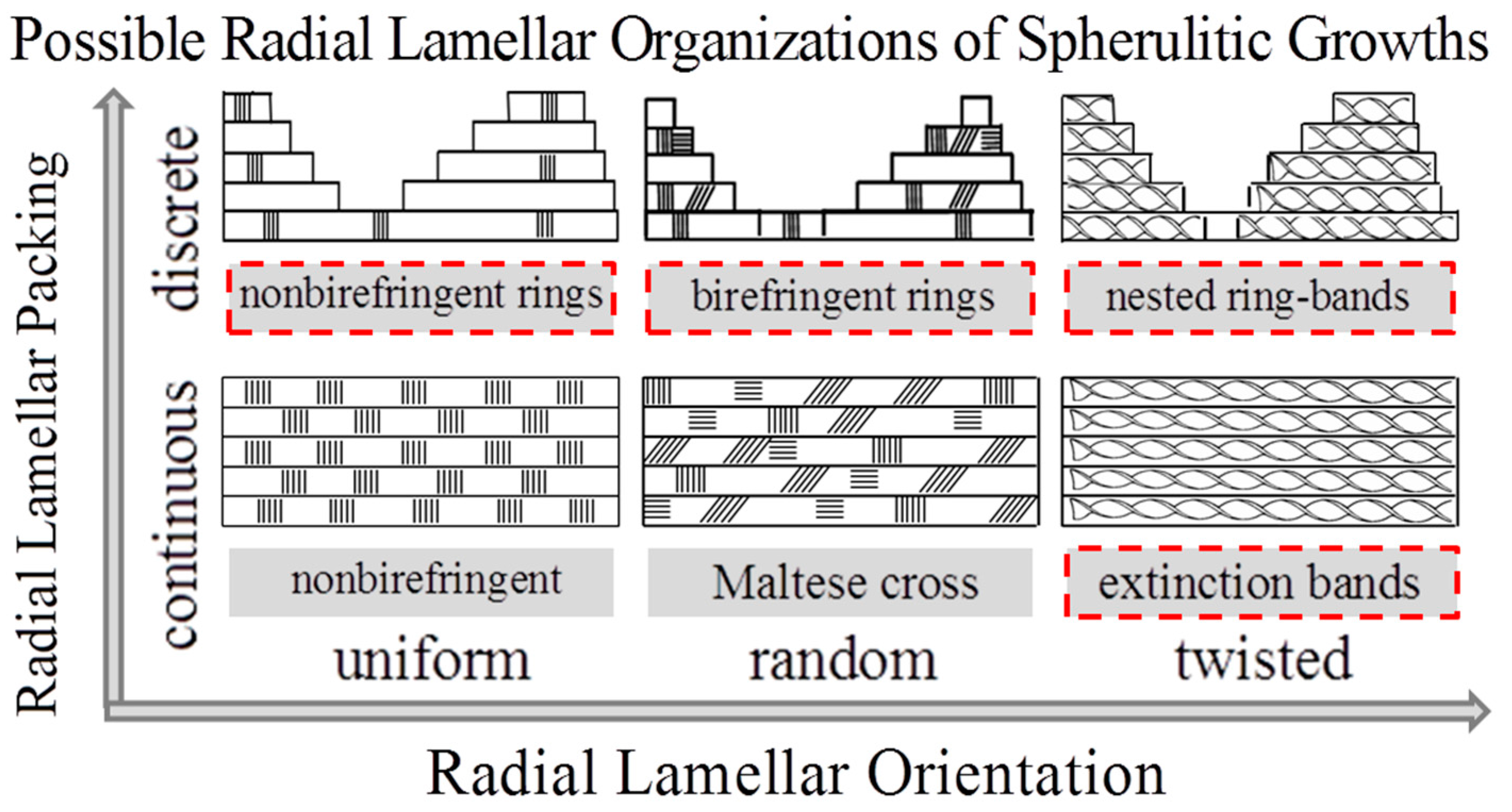


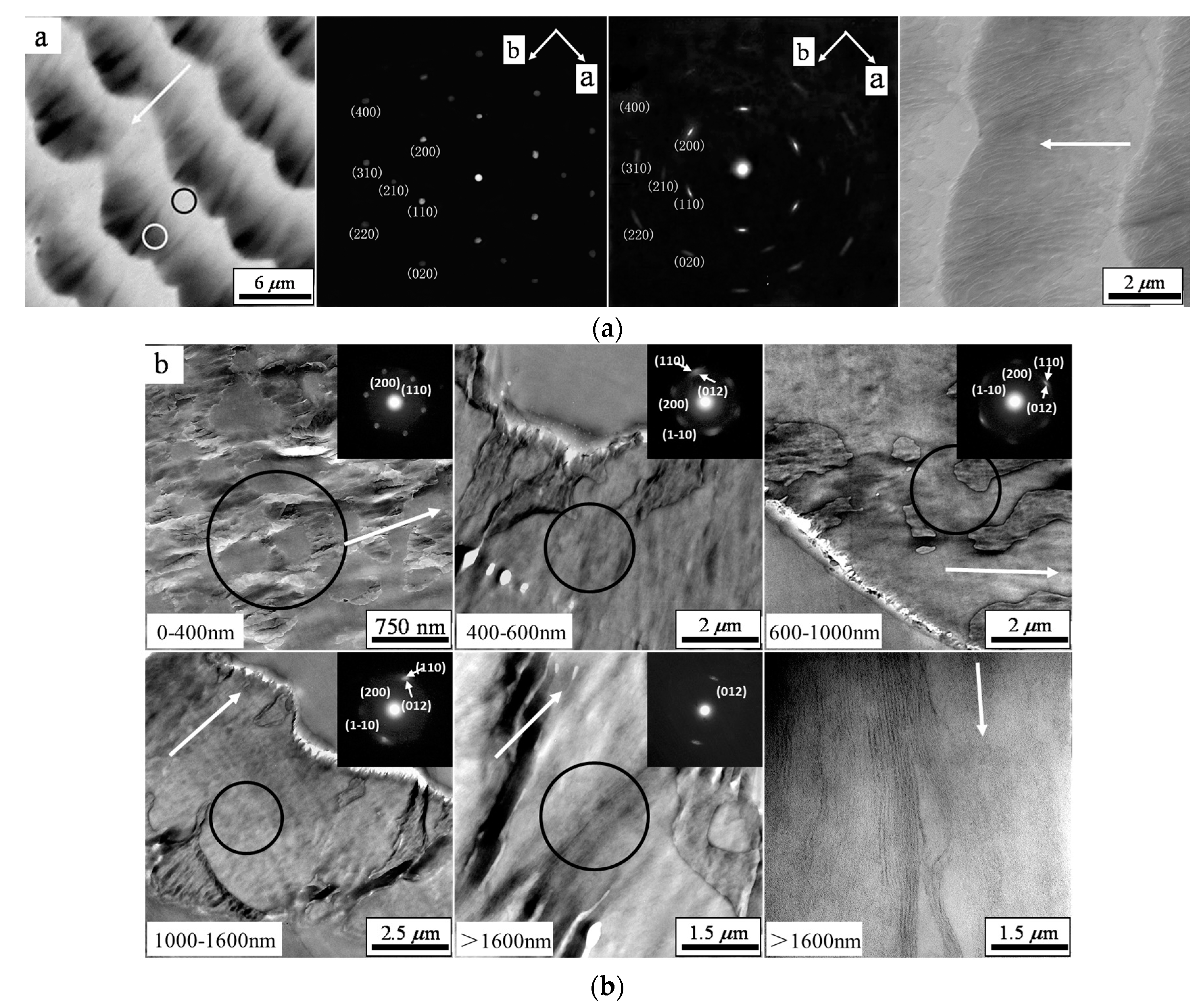

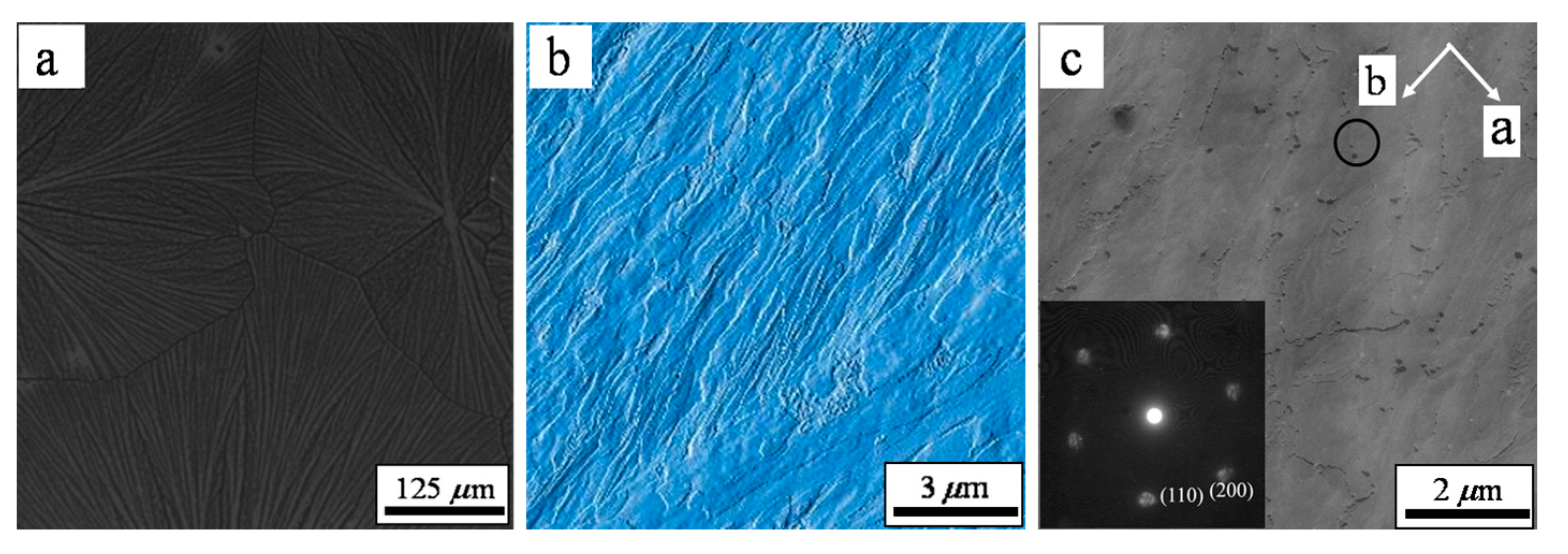




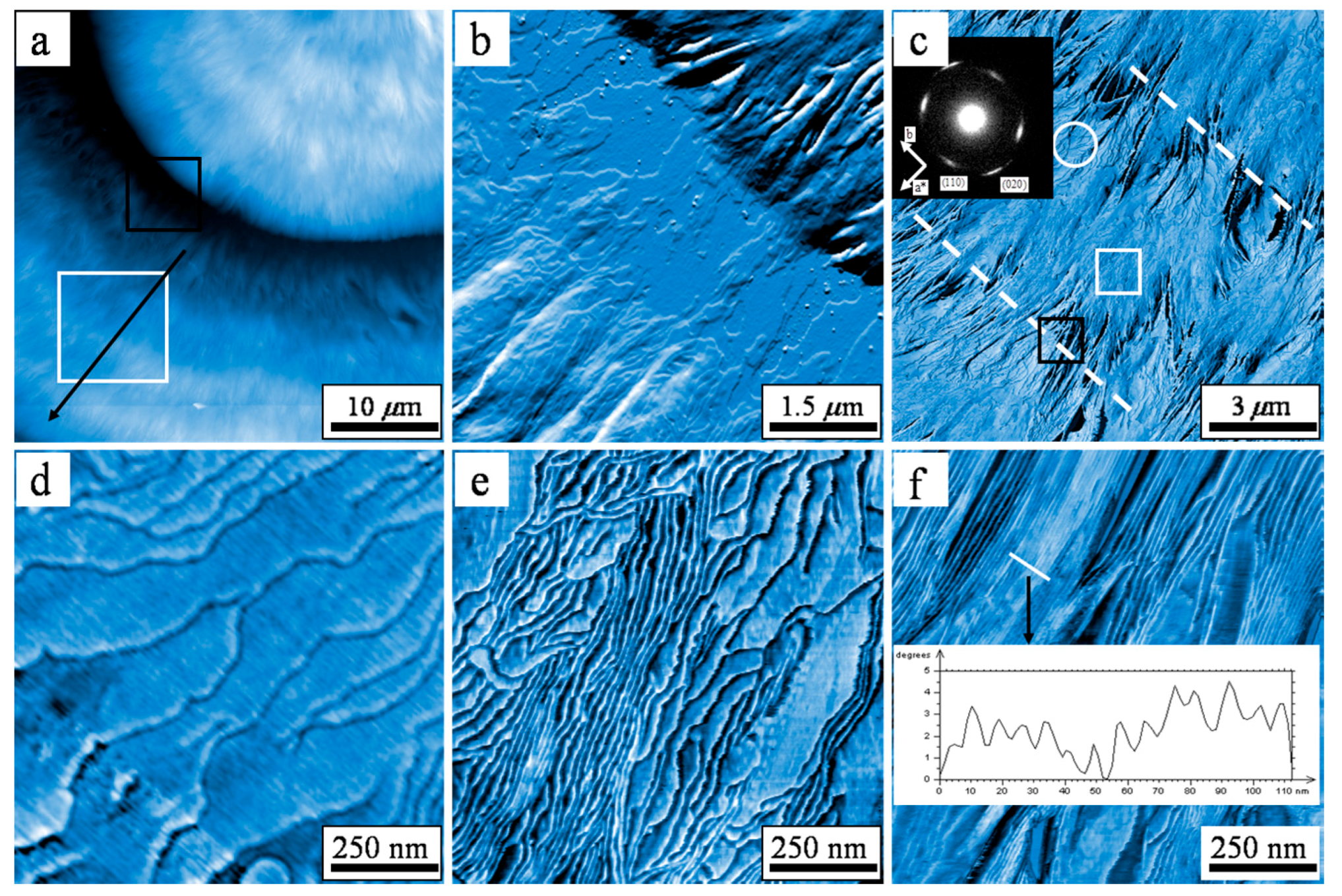
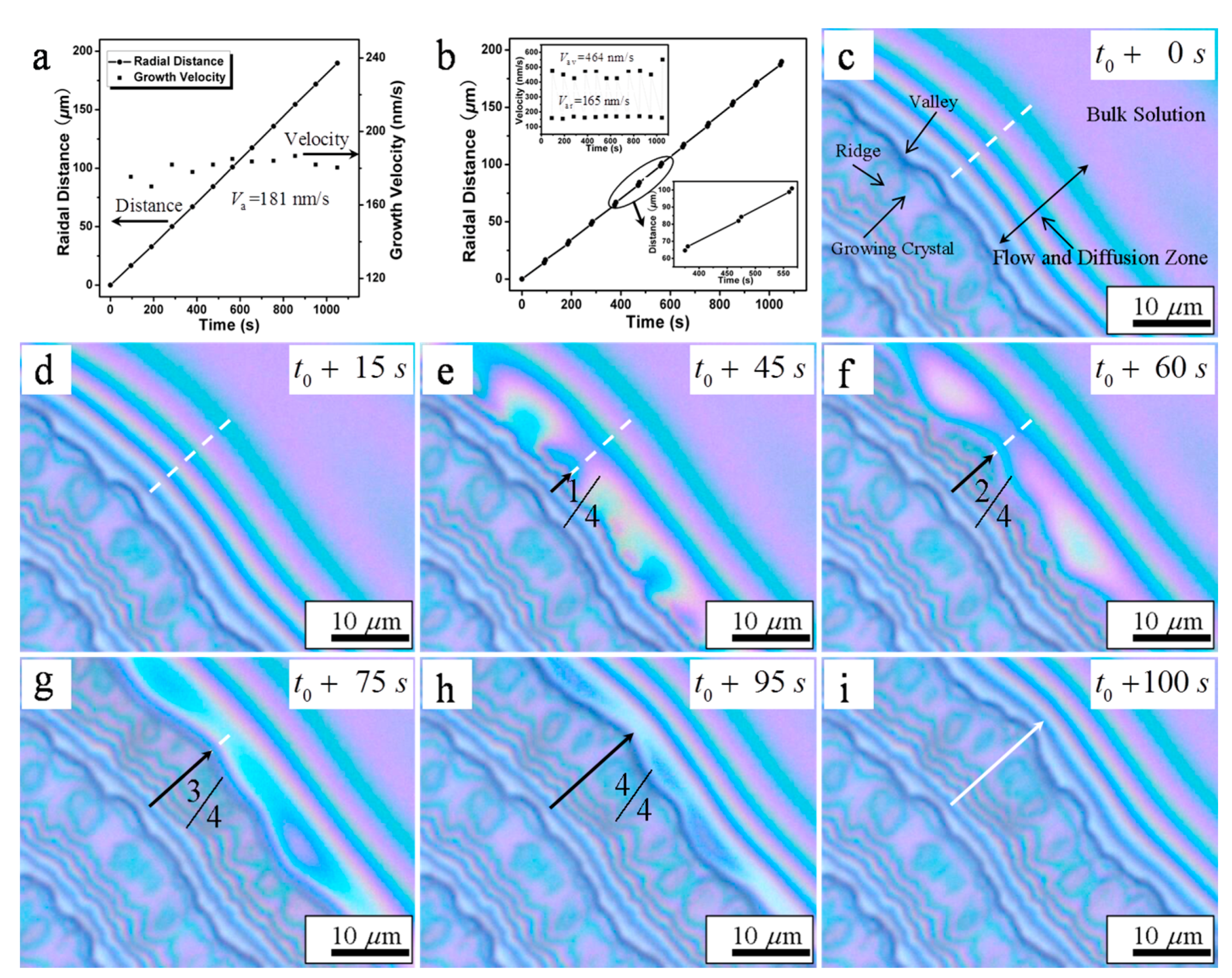
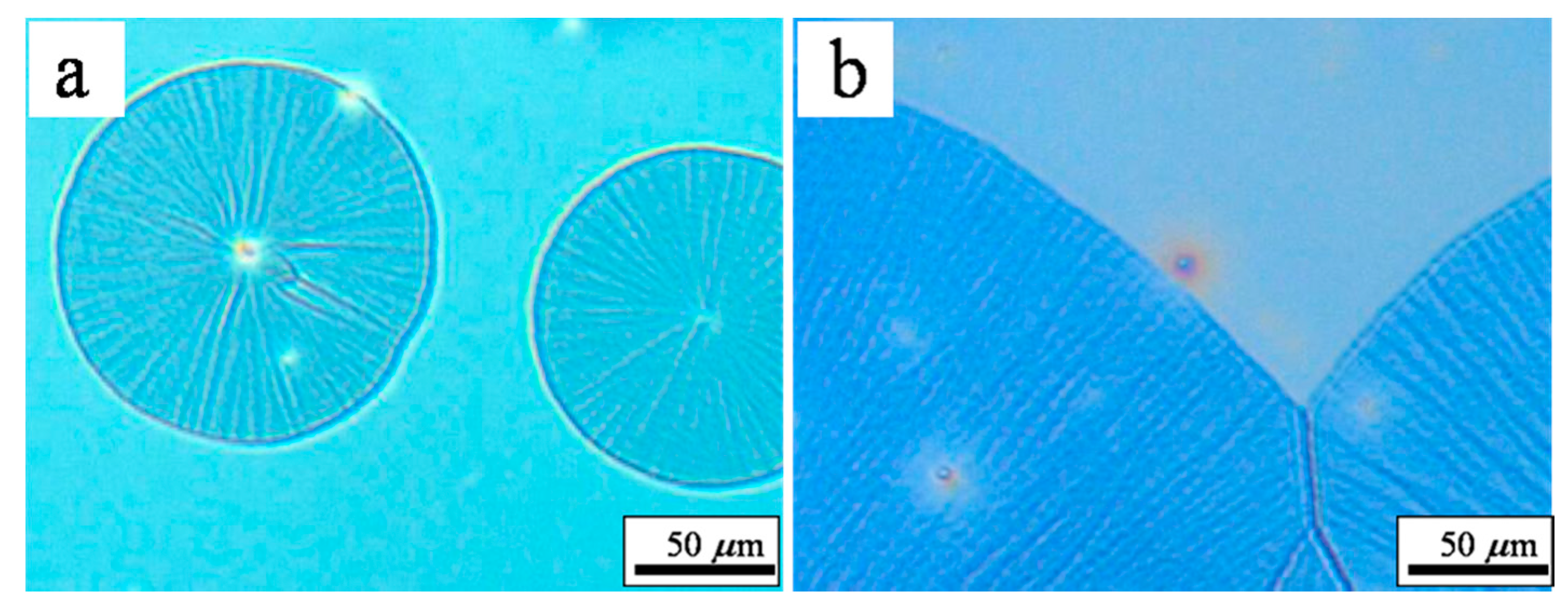

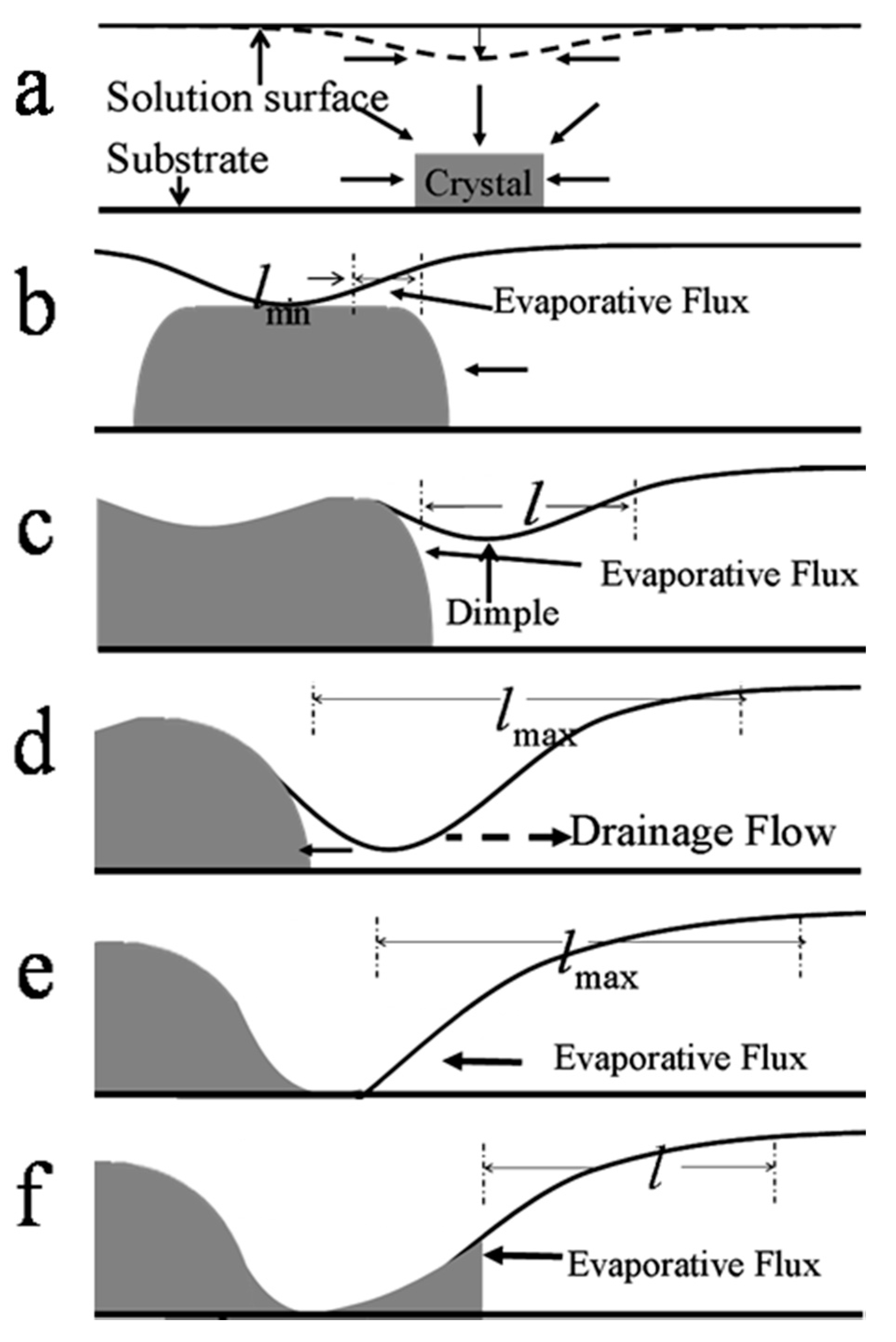

| Solutions | Mn (kg·mol−1) | Structural Feature of Polymer |
|---|---|---|
| PCL11.3k 1/toluene | 11.3 | Orthorhombic, low Mn |
| PCL42.5k/toluene | 42.5 | Orthorhombic, middle Mn |
| PCL84.4k/toluene | 84.4 | Orthorhombic, high Mn |
| PCL24.5k-b-PEO5.0k/toluene | CL: 24.5 EO: 5.0 | Orthorhombic, introducing a small amount of the second block |
| PEA10.0k/tetrahydrofuran | 10.0 | Monoclinic: chain tilt |
| Initial Solution Concentration (mg·mL−1) 1 | Average Radial Growth Rate (nm·s−1) | ||
|---|---|---|---|
| Concentrci Ringed Spherulites | Extinction Banded Spherulites | ||
| PCL11.3k | PCL24.5k-b-PEO5.0k | PCL84.4k | |
| 5 | 266 | 107 | 0.95 × 103 |
| 10 | 181 | 66 | 0.83 × 103 |
| 20 | 65 | 30 | 0.72 × 103 |
| 40(50 for PCL84.4k) | 44 | - | 0.61 × 103 |
| 100 | - | - | 0.56 × 103 |
© 2017 by the authors. Licensee MDPI, Basel, Switzerland. This article is an open access article distributed under the terms and conditions of the Creative Commons Attribution (CC BY) license (http://creativecommons.org/licenses/by/4.0/).
Share and Cite
Li, Y.; Wang, Z.; He, T. Morphological Control of Polymer Spherulites via Manipulating Radial Lamellar Organization upon Evaporative Crystallization: A Mini Review. Crystals 2017, 7, 115. https://doi.org/10.3390/cryst7040115
Li Y, Wang Z, He T. Morphological Control of Polymer Spherulites via Manipulating Radial Lamellar Organization upon Evaporative Crystallization: A Mini Review. Crystals. 2017; 7(4):115. https://doi.org/10.3390/cryst7040115
Chicago/Turabian StyleLi, Yiguo, Zongbao Wang, and Tianbai He. 2017. "Morphological Control of Polymer Spherulites via Manipulating Radial Lamellar Organization upon Evaporative Crystallization: A Mini Review" Crystals 7, no. 4: 115. https://doi.org/10.3390/cryst7040115






